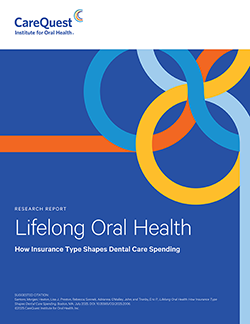The cost of oral health care poses the greatest financial barrier for individuals than any other type of health care, write the authors of a new report on dental care spending from CareQuest Institute. An interactive dashboard is also available for users to delve into spending by age, insurance type, and procedure.
The authors write:
Given the links between oral health and overall health, determining when and how the US spends its oral health care dollars — both through Medicaid and commercial plans — is key to understanding the overall health of the nation.”
The report examines oral health care spending for individuals aged 0 to 89 and evaluates differences in spending between Medicaid and commercial insurance plans. Key findings include:
- Both Medicaid and commercial spending on “preventive and basic dental care” was highest for children in the first decade of life, but commercial spending in this category was consistently higher for individuals of all ages.
- Commercial spending was consistently higher than Medicaid spending on “major dental care,” peaking in the first decade of life and then again around the age of 65.
- Lower average spending amounts by Medicaid do not necessarily reflect fewer oral health services but a lower rate of reimbursement compared to commercial plans.
You may also be interested in:
- Lifespan Time Trends (2019–2022), an interactive dashboard displaying average spending on oral health care by age, insurance type, and procedure.
- Dental Care in Crisis: Tracking the Cost and Prevalence of Emergency Department Visits for Non-Traumatic Dental Conditions, a report finding that costs for treating dental conditions in the ED have risen by $500 million to a total of $3.9 billion.
- The Need for Medicaid Adult Dental Coverage Across All States, a fact sheet outlining the health risks and economic consequences of Medicaid’s varying adult dental benefits across states.
